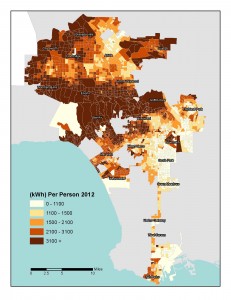CSUN Prof’s Research Explores Success of LADWP’s Energy Saving Programs

Yifei Sun
The project started out as a simple request by the Los Angeles Department of Water and Power to identify the areas of the city where the utility’s rebate and energy-saving programs were successful.
But, as California State University, Northridge geography professor Yifei Sun, who spearheaded the project, likes to point out, good research often raises more questions than it answers.
While Sun and a team of CSUN geography students found that LADWP’s residential and commercial clients were more energy efficient in 2012 than they were in 2009, the period they studied, they also discovered that the city’s energy consumption is socially, economically and geographically uneven.
“We found that the residents in neighborhoods that were more affluent — most likely in the foothills — tended to be more white and Asian in ethnic concentration used more electricity than those living in areas where the income was relatively lower,” Sun said about the report “Using GIS to Target Outreach for LADWP Customer Rebate Programs.” “But, interestingly enough, it was those same neighborhoods, those affluent neighborhoods, that participation in LADWP’s energy-saving rebate programs, by both residential and commercial clients, was the highest.
“You would think, given the rebate incentives LADWP offers its clients to convert to using more energy-efficient appliances, that the participation rate would be much higher in lower-income areas,” he said. “It wasn’t.”
LADWP officials approached Sun in January 2013 to help them identify where its energy-saving programs were succeeding among residential and commercial customers.

A map of residential consumption of electricity, from the study conducted by geography professor Yifei Sun and his students.
Using geographical information systems (GIS) and spatial statistical analysis, Sun and his students evaluated participation in different LADWP energy-efficiency programs between 2009 and 2012. They created maps that identified where the different energy-savings programs were offered and then analyzed changes in energy efficiency before and after the implementation of the programs. They also identified “hot spots,” the most efficient areas, and “cool spots,” the least efficient areas.
The goal, Sun said, was to help LADWP decision makers target outreach efforts and design more effective energy-saving initiatives.
The CSUN researchers found that energy consumption in the city of Los Angeles was improving but unevenly, with more affluent areas, many in the hills, consuming more than their lower-income counterparts just a couple miles away. However, neighborhoods that consumed more energy also were the areas with the most improved energy efficiency. Neighborhoods at the lower end of the economic scale show a decrease in energy efficiency between 2009 and 2012.
Of the various programs LADWP offers, some, such as consumer rebate programs, were successful in encouraging thousands of consumers to switch to more energy-efficient appliances and practices. Others that relied solely on educating the public about energy efficiency were significantly less successful.
While the research answered LADWP’s basic questions, Sun and his students were left with more.
“In the end, we found that some residential programs are effective in improving energy efficiency, while others are not,” he said. “But that left us asking, why have some programs been successful, while others have not? Why have some programs signed thousands of households and businesses, while others only a few? Is it because of the residents’ individual behaviors, or because of a lack of awareness of such programs? Do we have better ways of delivering messages about the programs to the customers? What can we do to change their behaviors?”
Sun and his students hope to answer those and other related questions this fall. LADWP will not be funding their research this time. Instead, Sun has received financial support for his project from the dean of CSUN’s College of Social and Behavioral Sciences, Stella Theodoulou.
“The reality is we need to get better at saving energy,” Sun said. “Perhaps, the answers we get to our questions will help LADWP and other utilities develop more effective outreach programs for their customers. Then, in the long run, we will all benefit.”

 experience
experience